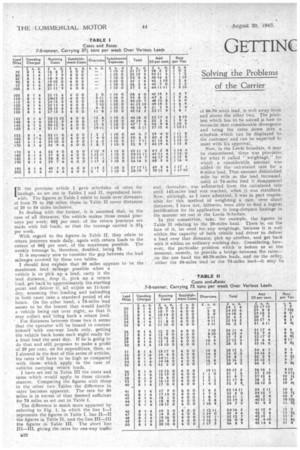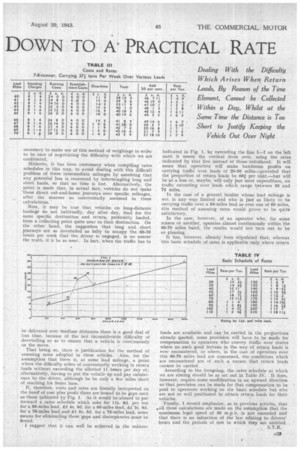GETTINC
Page 24

Page 25

If you've noticed an error in this article please click here to report it so we can fix it.
DOWN TO A: PRACTICAL RATE IN the previous article I gave schedules of rates for 'haulage, as set out in Tables I and II, reproduced here
with. The figures in Table I relate to hauls over distances of from 75 to 2Q9 miles: those in Table II cover distances of 20 to SO miles inclusive.
In dealing with the former, it is assumed that, in the case of all distances, the vehicle makes three round journeys per week; 601 per cent, of the return journeys are made with fullloads, so that the tonnage carried is 37i per week.
With regard -to the figures in Table II, they relate to return journeys made daily, again with-return loads to the extent of 661 per cent, of the maximum possible. The weekly tonnage is, therefore, doubled, being 75.
It is necessary now to consider the gap between the lead mileages covered by these two tables.
I should first explain that 50 miles appears to he the maximum lead mileage possible when a vehicle is to pick up a load, carry it the lead distance„ drop it, pick up a return load, get back to approximately the starting point and deliver it, all within an 11-hour day, assuming that leading and unloading in both cases take a standard period of six hours. On the other hand, a 75-miles lead seems to be the lowest that would justify a vehicle beinc, -out over night„ so that it may collect and bring back a return load. ' For distances between those two it seems that the operator will be bound to content himself with one-way loads only, getting the vehicle back home each night ready for a fresh load the next day. If he is goingto do that and still proposes to make a profit of 20 per cent, oh his expenditure, 'then, as I showed in the first of this series of articles, his rates will have to be high as compared with those which apply in the case of -vehicles carrying return loads. .` I have set out in Table HI the costs and rates which would apply in these circumstances. Comparing the figures with those in the other two Tables the difference in rates becomes apparent. The rate for 60 miles is in excess of that deemed sufficient for 75 miles as set out in Table I.
The difference is much more apparent by referring to Fig, 1, in which the line I—I represents the figures in Table I, line the figures in Table II; and the line the figures in Table III. The shOrt flne giving tht rates for one-way traffic
of 60-70 miles lead, is well-away from and above the other two. The problent which has to be solved is how to reconcile that considerable divergence and bring the rates down into a schedule., which can be displayed to the customer arid can be expected to meet with his approval.
Now, in the Leeds Schedule, it may be remembered, there was provision for what it called " weightage," for which a considerable. athOunt was added: to the calculated rate for a 6-miles-lead, That amount diminished mile by mile as the lead increased, until at 74-miles lead it disappeared and, thereafter, was subtracted from the calculated rate until 142-miles lead was reached, when .it was stabilized, Now, although, as .1 have admitted, I was in part respOnsible for this method of weighting a rate, over short distances, I have not, hitherto, been able to find a logical justification for its application to long-distance haulage iu the manner set out in the Leeds Schedule.
In this connection, take, for example, the figures in Table II relating to the 20-miles haul, There is, on the face of it, no need for, any weightage, because it is well within the capacity of both vehicle and driver to deliver a load over that distance, pick up another, and get back with it within an ordinary working day. Considering, however, the particular problem which is before us at the moment, namely, to provide a bridge -between the rates-,on the 0ne hand the 60-70-miles leads, and cm the other, either the 50-miles lead or the75-miles lead—it may be
necessary to make use of this method of weigh tage in order to be sure of negotiating the difficulty with which we are confronted.
Hitherto, it has been customary when compiling rates schedules in this way, to avoid dealing with this difficult problem of these intermediate mileages by assuming that any potential loss is recovered by intermingling long and short hauls, so that no time is lost. Alternatively, the point is made that, in actual fact, vehicles do not make 'these direct out-and-home journeys over specific mileages, after the manner so conveniently assumed in these calculations.
Now, it may be true that vehicles on long-distance haulage do not habitually, day after .day, load for. the same specific destination and return, preferably loaded, from a collecting point quite near to their destination. On the other hand, the suggestion that long and short journeys are so dovetailed as fully to occupy the 60-70 hours per week that the driver is engaged, is no nearer the truth, if it be as near. In fact, when the traffic has to be delivered over medium distances there is a good deal of lost time, because of the not inconsiderable difficulty of dovetailing so as to ensure that a vehicle is continuously on the move.
" That being so, there is justification for the method of assessing rates adopted in these articles. Also, for the assumption that there is, at some lead mileage, a point where the difficulty arises of conveniently working in return loads without exceeding the allotted II hours per day ot, alternatively, having to put the vehicle up and pay subsistence to the driver, although he be only a few miles short of reaching his home base.
If, therefore, costs and rates are literally interpreted on the basil of cost plus profit there are bound to be gaps such as those indicated bY Fig. I. As it would be absurd to put forward a rates schedule which asks for 11s. 8d. per ton for a 50-miles lead, El 4s. 9d. for a 60-miles lead, 41 7s. 9d. for a 70-miles lead and 41 Os. 5d for a 75-miles lead, some means for eliminating those 'gaps and discrepancies must be found.
' I suggest that it can well be achieved iu the manner indicated in Fig, 1, by extending the line I—I on the left until it meets the vertical from zero, using the rates . indicated by that line instead of those' calculated. It will mean that operators will• make handsome profits on carrying traffic over leads of 20-50 miles—provided that the proportion of return loads be 661 per cent.—but will be at a loss or, maybe, will only just meet expenditure, on traffic extending over leads which range .between 50 and /5 miles.
In the case of a general haulier whose lead mileage is not in any waylimited and who is just as likely to be carrying traffic over a 50-miles lead as over one of 60 miles, this method of assessing rates would prove to be quite satisfactory.
In the case, however, of an operator who, for some reason or another, operates almost continuously within the 60-70 miles band, the results would not turn out to be so pleasing. It has, however, already been stipulated that, whereas 'this basic schedule of rates is applicable only where return
loads are available and can be carried in the proportions already quoted, some provision will have to be made for compensation to operators who convey traffic over routes where no such good fortune in the way of return loads is ever encountered, or where, in the case of operators over this 60-70 miles lead are concerned, the conditions which are encountered are of •stich a nature that return loads cannot be carried.
According to the foregoing, the rates schedule at which we are aiming should be as set out in Table IV. It does, however, require some modification in an upward direction so that provision can be made for that compensation to be paid to operators working on the basic schedule but who are not so well positioned to obtain return loads for their vehicles.
Finally, I should emphasize, as in previous articles, that ,all these calculations are made on the assumption that the maximum legal speed of 30 m.p.h. is not exceeded and that there is no infraction of the law relating to drivers' hours and the periods of rest to which they are entitled. S.T.R.




















































